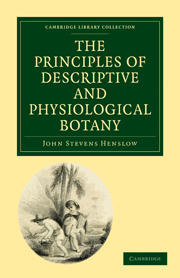Book contents
- Frontmatter
- Contents
- INTRODUCTION
- PART I DESCRIPTIVE BOTANY
- SECTION I ORGANOGRAPHY AND GLOSSOLOGY
- CHAPTER I ELEMENTARY ORGANS AND TISSUES
- CHAPTER II NUTRITIVE ORGANS
- CHAPTER III NUTRITIVE ORGANS — continued
- CHAPTER IV REPRODUCTIVE ORGANS
- CHAPTER V REPRODUCTIVE ORGANS — continued
- CHAPTER VI MORPHOLOGY
- SECTION II TAXONOMY AND PHYTOGRAPHY
- PART II PHYSIOLOGICAL BOTANY
- INDEX AND GLOSSARY
CHAPTER I - ELEMENTARY ORGANS AND TISSUES
Published online by Cambridge University Press: 05 December 2011
- Frontmatter
- Contents
- INTRODUCTION
- PART I DESCRIPTIVE BOTANY
- SECTION I ORGANOGRAPHY AND GLOSSOLOGY
- CHAPTER I ELEMENTARY ORGANS AND TISSUES
- CHAPTER II NUTRITIVE ORGANS
- CHAPTER III NUTRITIVE ORGANS — continued
- CHAPTER IV REPRODUCTIVE ORGANS
- CHAPTER V REPRODUCTIVE ORGANS — continued
- CHAPTER VI MORPHOLOGY
- SECTION II TAXONOMY AND PHYTOGRAPHY
- PART II PHYSIOLOGICAL BOTANY
- INDEX AND GLOSSARY
Summary
(8.) Organs. — The various parts of which a plant is composed have been called its “organs;” and this term is equally applied to those external portions, which may readily be recognised as being subordinate to the whole, such as its leaves, roots, flowers, &c, as to certain minute cells and vessels, of which its internal structure consists. De Candolle has included every inquiry, both into the external and internal organisation of plants, under the title of “Organography;” although such details as belong to their external characters have a more exclusive reference to our descriptive department, whilst those which relate to their internal organisation are more especially introductory to our physiological.
(9.) External Organs.— The principal external organs of which a plant is composed are familiar to every one. They are, the root, stem, branches, leaves, flowers, &c. These organs may be conveniently grouped under two heads, characterised by the nature of the functions which they are severally destined to perform. The root, stem, branches, leaves, and some other appendages to each of these, are concerned in carrying on the function of nutrition, or that act by which the life of every separate individual is maintained; and these are, in consequence, styled the “Conservative” organs. The flower and fruit, with their various appendages, are connected with the function of reproduction, by which the continuance of the species is provided for; and these are, therefore, named the “Reproductive” organs.
- Type
- Chapter
- Information
- Publisher: Cambridge University PressPrint publication year: 2009First published in: 1835

